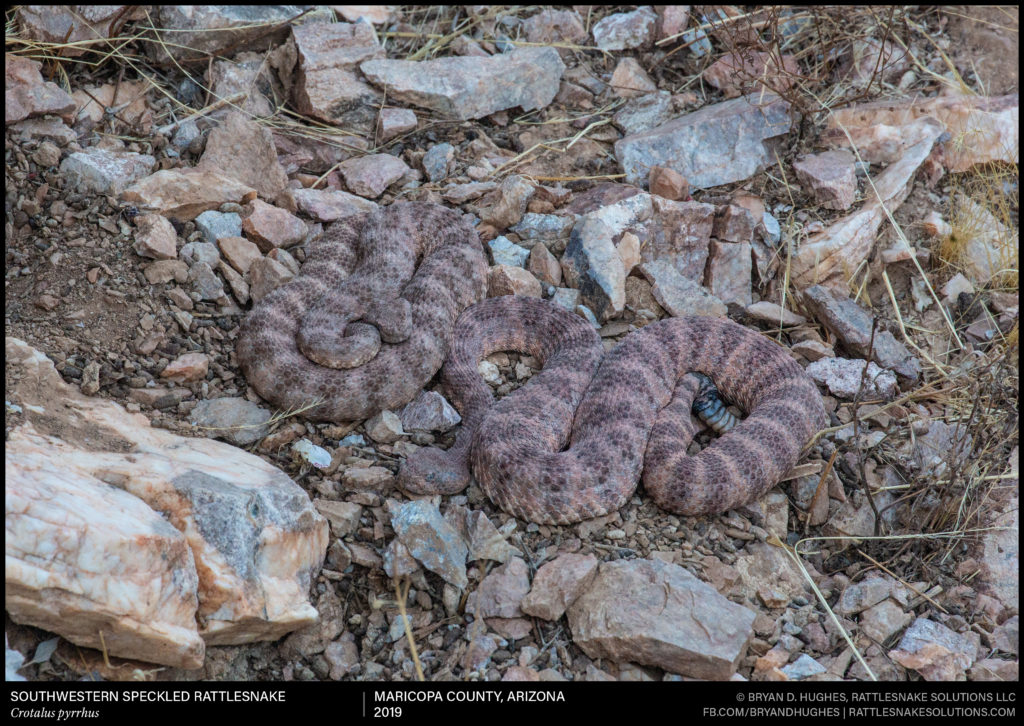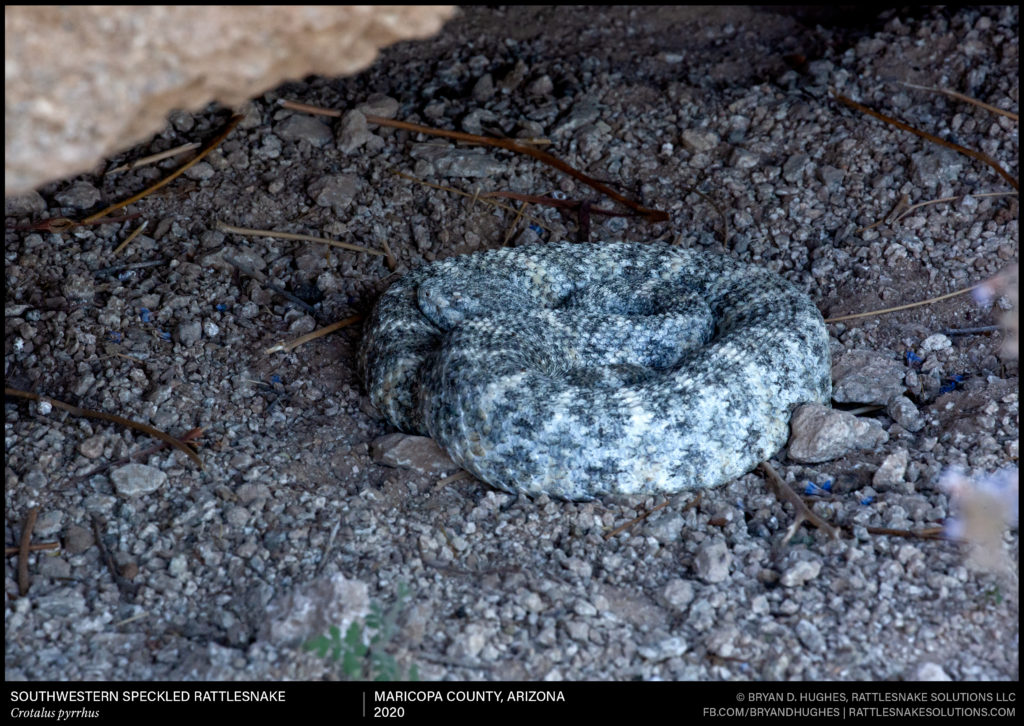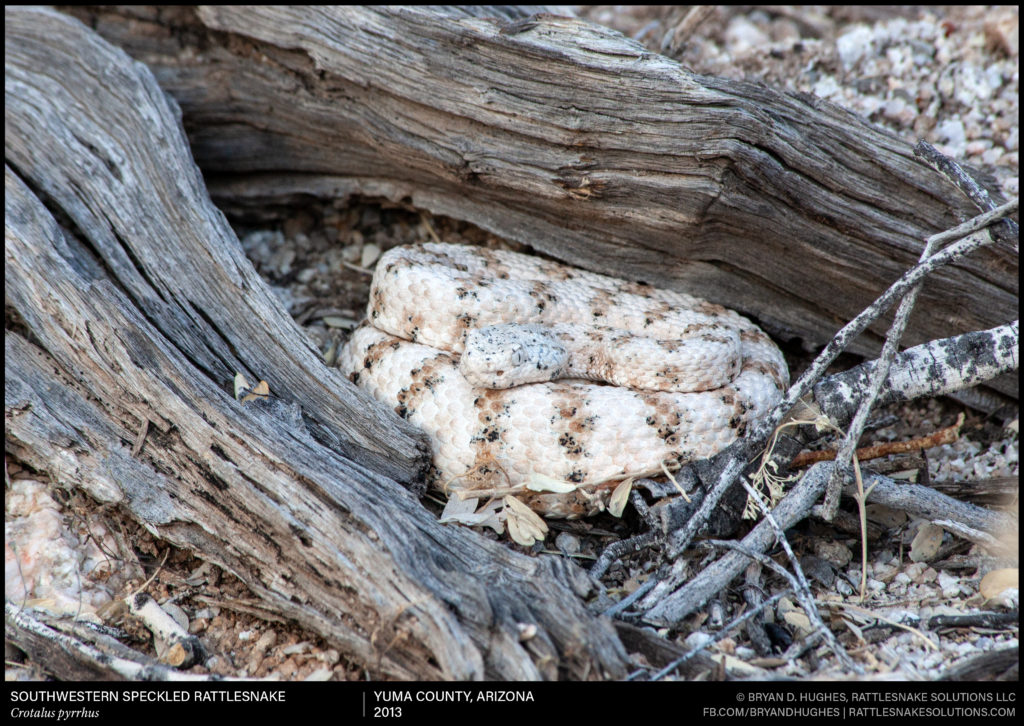
A note to herpers in AZ as we enter July and begin the monsoon season. In particular: those looking for Speckled Rattlesnakes.
This is definitely not aimed at any one person one group, but a common trajectory that plays out again and again. If this is you, listen up. This isn’t criticism; this is to help you see more snakes in the future and progress at what you love to do. I will also try to avoid the rant-format these types of posts tend to take on.
This is when you might find groups of Speckled Rattlesnakes (or other species, sometimes together), in small groups on your hikes. That’s one of the most exciting feelings you can have. I remember very well the season where things finally started to feel like it all made sense, and I could find specks at will any morning.
But something happened to those spots, and I want to talk about it so you can avoid making the same mistakes that I did, and many of us make early on. You don’t have to listen of course, but I guarantee that if you do, both you and the snakes you want to see will benefit.
The microhabitat that low-desert rattlesnakes choose for estivation and gestation sites is very specific. You can have a giant group of hillsides and ravines that all boil down to a handful of small holes where they gather to stay cool and safe throughout the hottest part of the year. These sites may be one of many they rotate between, but sometimes it appears to be just one, especially in areas where hikers and development have limited their options.
These summer sites are the hinge that their entire lives revolve on. They are every bit as sensitive and critically important as Winter dens for snakes in cooler environments. They are easily impacted and can be destroyed by what may seem like nothing.

So if you are visiting for starting to find these groups as described, here’s how this is going to go:
This year you’ll see so many specks – it’s going to be amazing, tons of photos, lots of learning, so many great experiences, etc. You’ll note the locations and feel like everything is finally starting to come together into a greater understanding of it all.
You’ll invite some friends … close ones you trust of course … life is good.
You will return to check on these sites a few times a week, sometimes even the next day. You hook them out if they start to retreat and pose them up for some great close-ups – they crawl off just fine, what’s the harm? You come home and post those photos immediately so the world can see.
Sometimes you can’t make it and your friends go without you. Sometimes they invite friends as well … close ones they trust of course.
But next year, you’ll come back to those sites and you’ll only see a handful of the snakes you saw before. Maybe it’s a bad year … the moon? Humidity too low? Who knows. You’ll keep visiting those sites hoping for a different result, but nothing changes. You spend most of your free herping time visiting old sites instead of exploring new ones. You still see great things, but not as great as last year! You do start to notice more footprints in that wash though, maybe a discarded gatorade bottle on the ground. Oh well, next year will be better.
The next year comes and now the weather and moon must really be bad, because there are no snakes at all at these spots. Where’d they go! There’s one snake deep in shed at one of them, but where are the others? There are now unrecognized footprints in the wash every time you go. You start recognizing rocks in photos from friends of friends of friends. You start seeing snakes you recognize on Instagram photos in hotel rooms. Herping starts to feel frustrating as you can’t decide on whether or not to explore for new spots or go check the old ones and hope something is happening.
The next year, the site is dead. Occasionally a random snake is there, but it’s nothing of what it was a few years ago. The last time you went there, too, you ran into a couple of guys you don’t know from out of state who heard this was a good place.
So now the choice you’ll have: evaluate what happened, or carry on and repeat this process?
The dopamine response we all develop to seeing and sharing rattlesnake experiences is strong. It’s like ordering a pizza and as soon as it arrives, throwing it in the fridge and going to bed hungry. It can make truly evaluating our actions in the field and potential impact to critical habitat nearly impossible. It’s also the biggest enemy to having repeat encounters; to move past the point of herping being a series of random events, it’s also important to overcome.

Here’s what happens:
Small stress events, even ones that we don’t even notice … like getting a close up cellphone shot and the snake never tongue-flicks, build up. There are numerous studies of stress-response in several species of rattlesnakes (specks aren’t one of those, yet) if you want to look at it in depth. Those repeated stress events cause the behavior of the snakes to change. Sometimes it just means they’ll spend more time under bushes and out of view and they’re harder to detect, so you walk past more of them instead of the wide-open ambush positions you’re used to. But with these low-desert snakes, they tend to leave entirely. They may end up at a different estivation area. Sometimes that site isn’t as good as the one they originally selected, and sometimes that has negative consequences for the snake, up to and including death.
A single event, or managed stress events that are spaced out adequately avoid this effect. However, there are exceptions.
Rattlesnakes die at a surprisingly low temperature. Once the body gets into there 105-110 range, they are on death’s door. Even if they crawl away seemingly fine, they may not recover. On hot nights, specks will sit out until they are only a few degrees shy of their upper terminal temperature, then make a bee-line for cover. If you are buzzed during this process, then hold it up for a 20 minute photo session, then let it crawl away rattling to cover, you very well may have killed that snake and you will never know it. If the place they retreat to after the encounter is not suitable to survive a 110F+ inferno for the day: it’s dead.
Would you visit a horridus den and hook the snakes out the crevices to photograph? Would you pull them out in the coldst days of winter and pose them on open ice for a half hour shoot and let them crawl off into the snow? Would you flip every rock in a stream for hellbenders and pose them in the sun before releasing them into the sand? Would you dig an eastern massasauga out of a crawfish burrow for photos and leave it in the sun? Of course not – these are ridiculous actions that we know have consequences. For whatever reason, the nature of critical microhabitat for hot-desert species is largely missing from the herper lexicon.
It might be that the perceived abundance of rattlesnakes in Arizona makes it harder to see. It could be that, despite rattlesnakes in general being one of the most well-studied vertebrates on the planet, what they do when temps get to 110F is poorly documented. It could be that they are common animals in common places, so people simply don’t care if they are negatively affected. It could also be, and this is what I assume to be unfortunately true in many cases: the potential for damage is known, but the draw for the excitement of experience and sharing make it less important. I am sure we have all seen specks posed in the open on rocks where the shadow positions reveal the time by herpers who are experienced to know better. I can only guess why this feels acceptable.
Maybe it’s because they never see the results, other than the die-off of estivation sites each year. If that’s just chalked up to “must be a bad year”, as it tends to be, the lesson is never learned personally. Unfortunately, that mess is apparent to those who look for it.
A couple of us are working on a research project in a few areas that are often herped. There is nothing stated above that has not been well-documented, and eventually published. We set out to learn about where and when snakes use different microhabitat. As it progresses, however, the regretful picture of just how quickly well-intentioned herpers can kill off critical habitat is emerging. I hate it, but it’s right there and can’t be ignored. Once an area is discovered by herpers and visited frequently, it changes dramatically. Compared to similar sites that are either not herped or herped at spaced intervals to manage stress, repeated visits by groups of well-intentioned herpers is third in line of destruction of those sites to development and transient use.
Single or rare stress events, even if substantial, seem to not have any impact. Limiting visits to a sensitive site to just a handful a year can mitigate the negative issues I’ve described here. It’s an investment. You’re trading dopamine for future encounters.
This is what gives the Arizona herping community a bad reputation as people who go overboard on coming down on how and where people herp. There’s a reason for this: this is one of the herping hotspots of the world. Every person who seems over the top in their approach is coming from a position of watching sensitive sites be decimated each year. So while that message can certainly be handled better, try and see the underlying message.
All of this is why it seems you can’t so much as post a cell-phone shot of a snake here in Arizona without a bunch of old-timers coming out of the woodwork to tell you you’re doing it wrong. The fact is: they are right, but they need to put it in a better package. Let’s be honest about all this: we all know each other because we like reptiles, not because we’re all aligned on a social level.
So I’m asking you to try this: next time you see a speck in a wash, ask yourself:
Do you want to see this snake again? Is this more enjoyable as a one-off experience, or as an observation spot to visit for a lifetime?
Is my understanding and sharing of this experience better as a piled stress-ball, or as numerous future observations and hundreds of photographs of what this snake actually does?
Is approaching this snake up close for a cell-shot worth it. Is what I am doing hurting or helping?
Is it worth it to post that photo the moment I get home? Is the experience less enjoyable if I wait until after aestivation season to do it?
If you don’t think that people can triangulate your position based on a telephone pole and a dirt road in the background, you’re wrong … and thanks for the site 😉
If you think that a snake wasn’t bothered by you because it didn’t tongue flick after that up close cellphone shot: come back in 10 minutes and see where it’s at.
If you don’t think that hundreds of people planning AZ monsoon trips, some much less well-intentioned or ethical as you are, aren’t watching every move you make and every photo you post: be aware that they are.
If you value the experience of visiting specks at the sites you’ve found: please consider all of this.
Or, disregard if you like. Just remember it in a few years when that speck honey hole seems to have dried up. Guess what: it’s not the full moon.

